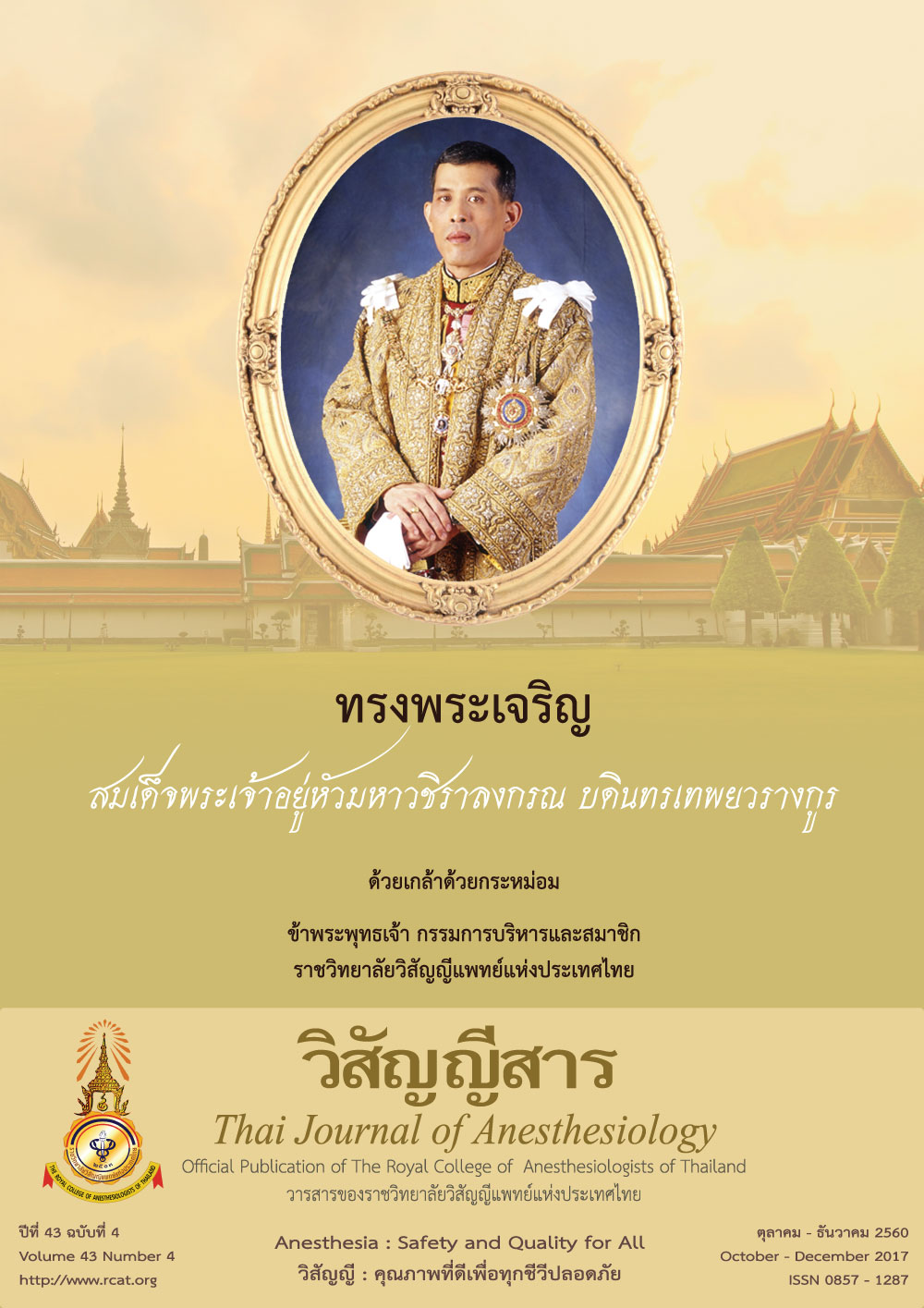A comparison study of 2 mg versus 4 mg of dexamethasone combined with local anesthetic drug in increasing the analgesic duration of a single-shot supraclavicular brachial plexus block
Main Article Content
Abstract
Background: Addition of dexamethasone to
local anesthetic can prolong the analgesic duration in
peripheral nerve block. However, the proper adding
dose of dexamethasone for brachial plexus block
can not be concluded. Objectives: To compare the
analgesic duration of dexamethasone 2 versus
4 mg added to local anesthetic drugs following
supraclavicular brachial plexus block. Methods: This
study was a double-blinded randomized controlled
trial. Fifty seven patients undergoing upper extremity
surgery were randomly assigned to 3 groups. All
patients received 20 ml of 2% lidocaine with
adrenaline 5 mcg/ml and 10 ml of 0.5% bupivacaine
for supraclavicular brachial plexus block. Same
volume of normal saline, dexamethasone 2 mg and
dexamethasone 4 mg were added to local anesthetics
in C group, Dex2 group and Dex4 group, respectively.
Results: Median and 95% CI of analgesic duration
in Dex2 and Dex4 group were 620(440-837),
894(652-960) minutes which were longer than C group
[335(259-491)] significantly (p-value 0.001). Analgesic
duration in Dex4 group was longer than Dex2 group
(p-value < 0.05). Both of dexamethasone groups had
longer duration of motor block than C group [Dex2
group 525(441-720), Dex4 group 518(467-840),
C group 420(310-483) minutes, p-value 0.0028).
However, there was no difference in duration of
motor block between Dex2 and Dex4 group.
Morphine consumption in C group was more than
both of dexamethasone groups. No adverse events
were noted in all groups. Conclusion: Adding
dexamethasone 4 mg in supraclavicular BPB has
longer duration of analgesia than dexamethasone
2 mg with a comparable duration of motor block.
Article Details
References
LM, Kalkman CJ, Meissner W. Pain intensity on the first
day after surgery: a prospective cohort study comparing
179 surgical procedures. Anesthesiology. 2013;118(4):
934-44.
2. Neal JM, Gerancher JC, Hebl JR, Ilfeld BM, McCartney
CJ, Franco CD, et al. Upper extremity regional anesthesia:
essentials of our current understanding, 2008. Reg Anesth
Pain Med. 2009;34(2):134–70.
3. Cummings KC , Napierkowski DE, Parra-Sanchez I,
Kurz A, Dalton JE, Brems JJ, et al. Effect of dexamethasone
on the duration of interscalene nerve blocks with
ropivacaine or bupivacaine. Br J Anaesth. 2011;
107(3):446–53.
4. Ilfeld BM, Morey TE, Wright TW, Chidgey LK,
Enneking FK. Continuous interscalene brachial plexus
block for postoperative pain control at home: a randomized,
double-blinded, placebo-controlled study. Anesth Analg.
2003;96(4):1089-95.
5. Popping DM, Elia N, Marret E, Wenk M, Tramer
MR. Clonidine as an adjuvant to local anesthetics for
peripheral nerve and plexus blocks: a meta-analysis of
randomized trials. Anesthesiology. 2009;111(2):406–15.
6. Adhikary SD, Armstrong K, Chin KJ. Perineural entrapment
of an interscalene stimulating catheter. Anaesth Intensive
Care. 2012;40(3):527–30.
7. Aveline C, Le Hetet H, Le Roux A, Vautier P, Gautier JF,
Cognet F, et al. Perineural ultrasound-guided catheter
bacterial colonization. Reg Anesth Pain Med. 2011;36(6):
579–84.
8. Bowens C Jr, Briggs ER, Malchow RJ. Brachial plexus
entrapment of interscalene nerve catheter after
uncomplicated ultrasound guided placement. Pain Med.
2011;12(7):1117–20.
9. Choi S, Rodseth R, McCartney CJ. Effects of
dexamethasone as a local anesthetic adjuvant for
brachial plexus block: a systematic review and meta-
analysis of randomized trials. Br J Anaesth. 2014;112(3):
427-39.
10. Albrecht E, Kern C, Kirkham KR. A systematic review and
meta-analysis of perineural dexamethasone for peripheral
nerve block. Anesthesia. 2015;70(1):71-83.
11. Attardi B, Takimoto K, Gealy R, Severns C, Levitan ES.
Glucocorticoid induced up-regulation of a pituitary K+
channel mRNA in vitro and in vivo. Receptors Channels.
1992;1(4):287-93.
12. Eker HE, Cok OY, Aribogan A, Arslan G. Management
of neuropathic pain with methylprednisolone at the site
of nerve injury. Pain Med. 2012;13(3):443-51.
13. Johansson A, Hao J, Sjolund B. Local corticosteroid
application blocks transmission in normal nociceptive
C-fibers. Acta Anesthesiol Scand. 1990;34(5):335-8.
14. Honnannavar KA, Mudakanagoudar MS. Comparison
between conventional technique and ultrasound guided
supraclavicular brachial plexus block in upper limb
surgeries. Anesth Essays Res. 2017;11(2):467-71.
15. Huynh TM, Marret E, Bonnet F. Combination of
dexamethasone and local anaesthetic solution in
peripheral nerve blocks: a meta-analysis of randomised
controlled trials. Eur J Anaesthesiol. 2015;32(11):751-8.
16. De Oliveira GS, Castro Alves LJ, Nader A, Kendall MC,
Rahangdale R, McCarthy RJ. Perineural dexamethasone
to improve postoperative analgesia with peripheral nerve
blocks: a meta-analysis of randomized controlled trials.
Pain Res Treat. 2014;2014:179029.
17. Kopacz DJ, Lacouture PG, Wu D, Nandy P, Swanton R,
Landau C. The dose response and effects of dexamethasone
on bupivacaine microcapsules for intercostals blockade
(T9 to T11) in healthy volunteers. Anesth Analg. 2003;
96(2):576–82.
18. Takimoto K, Levitan ES. Glucocorticoid induction of
Kv1.5 K+ channel gene expression in ventricle of rat
heart. Cir Res. 1994;75(6):1006-13.
19. Castillo J, Curley J, Hotz J, Uezono M, Tigner J, Chasin
M, et al. Glucocorticoids prolong rat sciatic nerve blockade
in vivo from bupivacaine microspheres. Anesthesiology.
1996;85(5):1157-66.
20. Benzon HT, Chew TL, McCarthy RJ, Benzon HA,
Walega DR. Comparison of the particle sizes of different
steroids and the effect of dilution: a review of the
relative neurotoxicities of the steroids. Anesthesiology
2007;106(2):331–8.
21. Desmet M, Braems H, Reynvoet M, Plasschaert S,
Van Cauwelaert J, Pottel H, et al. IV and perineural
dexamethasone are equivalent in increasing the analgesic
duration of a single-shot interscalene block with
ropivacaine for shoulder surgery: a prospective,
randomized, placebo-controlled study. Br J Anaesth.
2013;111(3):445-52.


